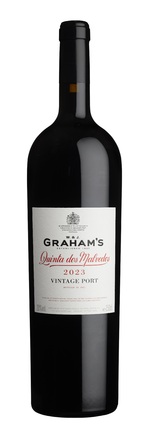
MAGNUMS In Bond
"First impressions on the nose are the trademark Malvedos mint and eucalyptus with hints of orange blossom and a touch of rock rose. Typical Graham opulence and generosity on the palate with layered flavours of blackberry and blueberry, black chocolate and cocoa. Bright acidity and peppery tannins provide freshness and a balanced structure. Touriga Nacional (59%); Touriga Franca (19%); Alicante Bouschet (16%); Sousão (6%)."
Founded in 1820 by William and John Graham in Portugal’s Douro Valley, for nearly two centuries Graham’s has cultivated its reputation as one of the greatest names in Port. The quality of Graham’s Port relies on the finest grapes from five iconic quintas in the Douro Valley: Quinta dos Malvedos, Quinta do Tua, Quinta das Lages, and two others, Quinta da Vila Velha and Quinta do Vale de Malhadas, which are privately owned by a member of the Symington family. Located in the heart of the Upper Douro Valley, all of these quintas enjoy the hot and dry microclimate and unique schist soil only found in this region. Together these two factors provide perfect conditions for both the growth and optimum ripening of the grapes.
Quinta dos Malvedos has been the cornerstone of Graham’s Vintage Ports ever since it was acuired in 1890. The 160-hectare estate is particularly well-sited in a zone of transition from the Cima Corgo to the Douro Superior subregions of the Douro Valley, bringing together the best of both, it enjoys reasonable rainfall and abundant sunshine. The vineyards are predominantly south-facing and the ample hours of sunlight provide even and complete grape ripening, resulting in very well-balanced wines. The estate still contains large areas of traditional vineyard laid out on terraces supported by dry-stone walls, built by hand in the 18th century.
Abundant rainfall during the first half of the winter reversed the severe drought of 2022, replenishing soil water levels satisfactorily. Although February to April was an exceptionally dry and mild period, generous late spring rainfall in May and June sustained the vines over the ripening cycle. While much of Europe was blasted by extreme heatwaves during the summer, July temperatures in Portugal were close to normal and in the Douro fractionally below average. Although there was virtually no rainfall in the Douro during July and August, reasonable soil moisture, combined with comparatively moderate temperatures, favoured good levels of acidity, balanced maturations, and good phenolic development. Perfectly timed rain in early September provided a great start to the vintage, and we picked under fine conditions during the first half of the month. From mid-September, excessive rainfall affected later ripening grapes, but many of our finest vineyard parcels had been picked before the rain, enabling us to produce some very fine wines.